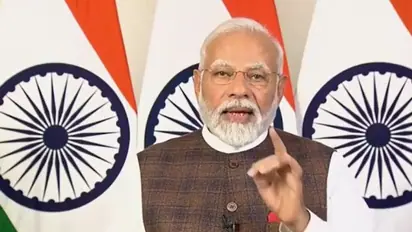'India is now on the Moon...' PM Modi celebrates Chandrayaan-3's lands on lunar surface

Synopsis
"Like every countryman, my mind was also focused on the Chandrayaan mission. As soon as new history is made, every Indian is immersed in celebration, celebration has started in every house," the Prime Minister said.
Prime Minister Narendra Modi joined the nation in celebration of the Chandrayaan-3 mission's Vikram lander touching down on the Moon successfully. No other country has been able to land on this side of the moon before; this will change all narratives and stories about the Moon, he said.
While stating that India's successful Moon mission is not just India's alone, but a success that belongs to all of humanity, the Prime Minister said: "No country has reached there (the South Pole of the moon) before. With the hard work of our scientists, we have reached there. This is a year in which the world is witnessing India’s G20 presidency. Our approach of one earth, one family, one future is resonating across the globe."
In a statement, he said: "When we see such history being made in front of our eyes, then the creature becomes blessed. Such historical events become the eternal consciousness of the nation's life. Like every countryman, my mind was also focused on the Chandrayaan mission. As soon as new history is made, every Indian is immersed in celebration, the celebration has started in every house."
India has achieved a historic milestone by becoming the first nation to successfully land near the Moon's South Pole, a region of renewed interest following the discovery of water traces. The momentous touchdown occurred at 6.04 pm, resonating with cheers in the war room of the Indian Space Research Organisation (ISRO). Social media platforms were flooded with congratulatory messages.
Over the next 14 days, equivalent to one lunar day, the Pragyan Rover will transmit images and data from the Moon's surface. However, its activity is expected to gradually slow down afterwards, as it relies on solar cells for power.
The landing itself involved a series of precise manoeuvres. The Vikram lander, powered by four engines, deactivated two of them to reduce speed during the final 30 kilometres of descent, ultimately achieving the challenging soft landing.
The successful landing stirred up a considerable amount of fine lunar dust. The Pragyan Rover will only commence its exploration once this dust has settled, unlike on Earth, where gravity assists dust settling.
The Moon lander embarked on its journey on July 14, carried by an LVM 3 heavy-lift launch vehicle, and was placed in lunar orbit on August 5. Notably, the lander, Vikram, bears the name of Vikram Sarabhai, widely recognized as the founding figure of India's space program.
Stay updated with the Breaking News Today and Latest News from across India and around the world. Get real-time updates, in-depth analysis, and comprehensive coverage of India News, World News, Indian Defence News, Kerala News, and Karnataka News. From politics to current affairs, follow every major story as it unfolds. Get real-time updates from IMD on major cities weather forecasts, including Rain alerts, Cyclone warnings, and temperature trends. Download the Asianet News Official App from the Android Play Store and iPhone App Store for accurate and timely news updates anytime, anywhere.